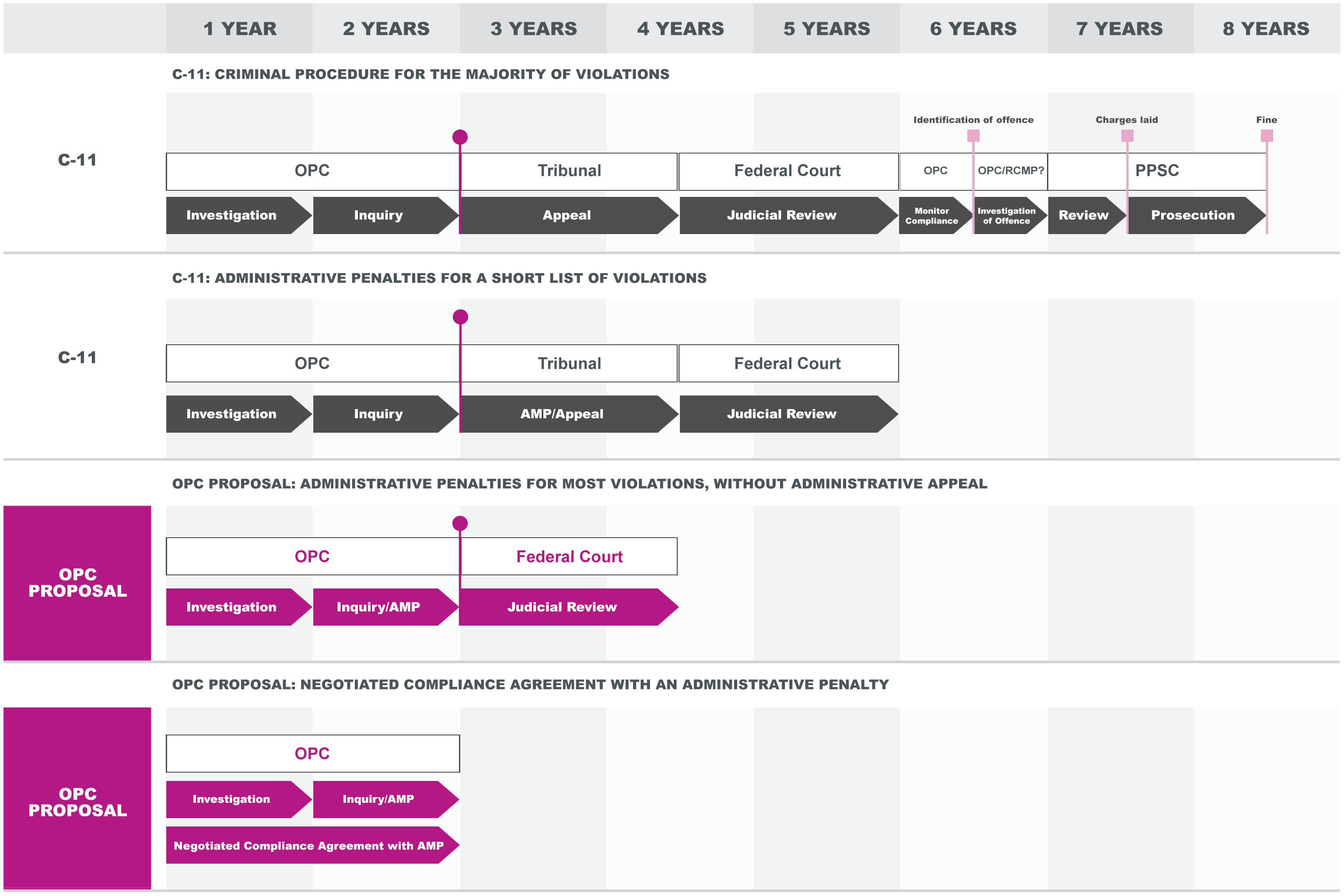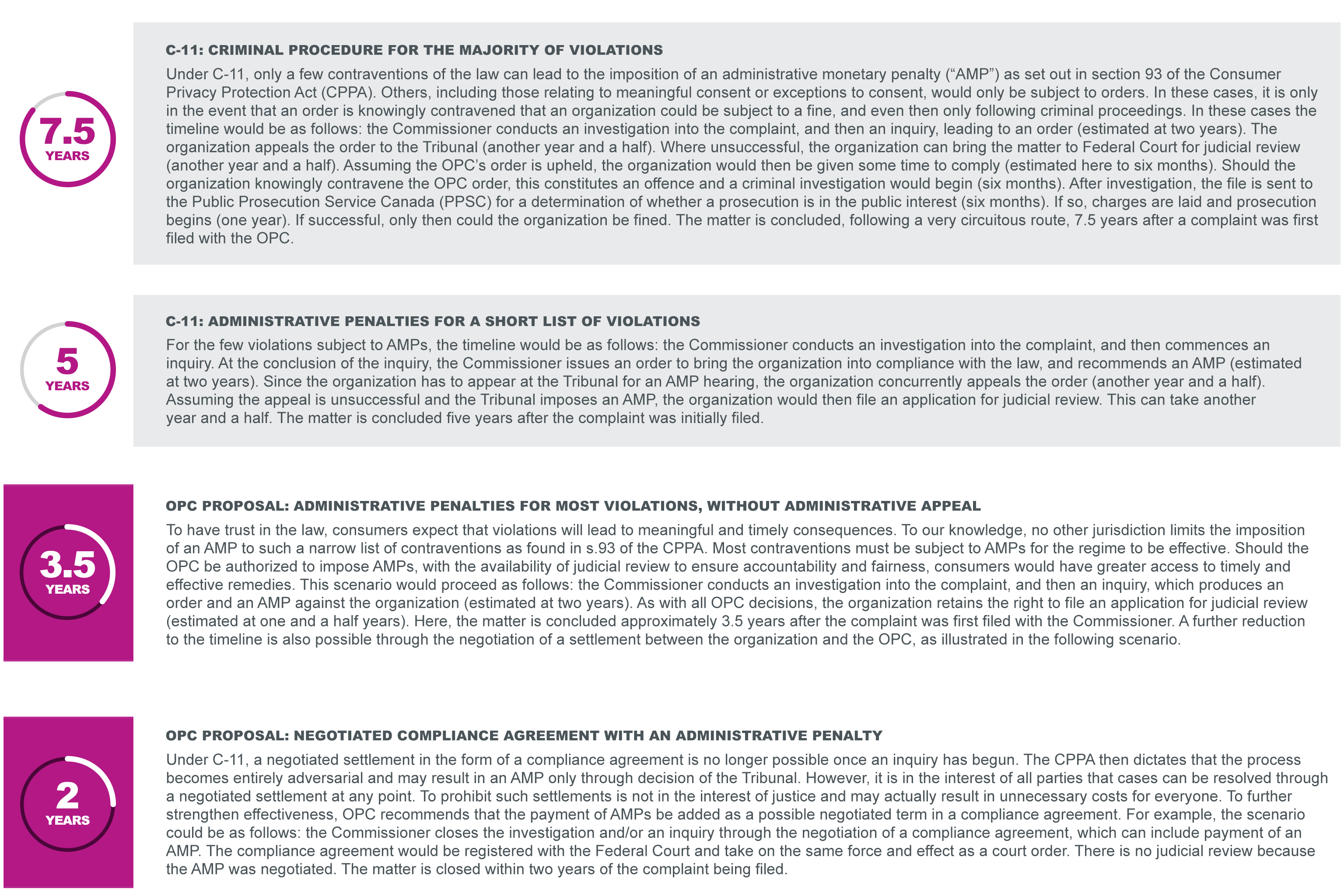Backgrounder: Complaint timelines under various C-11 scenarios


Text version of the C-11 Timelines and Scenarios
C-11: Criminal procedure for the majority of violations
Under C-11, only a few contraventions of the law can lead to the imposition of an administrative monetary penalty (AMP) as set out in section 93 of the CPPA. Others, including those relating to meaningful consent or exceptions to consent, would only be subject to orders. In these cases, it is only in the event that an order is knowingly contravened that an organization could be subject to a fine, and even then only following criminal proceedings. In these cases the timeline would be as follows: the Commissioner conducts an investigation into the complaint, and then an inquiry, leading to an order (estimated at two years). The organization appeals the order to the Tribunal (another year and a half). Where unsuccessful, the organization can bring the matter to Federal Court for judicial review (another year and a half). Assuming the OPC’s order is upheld, the organization would then be given some time to comply (estimated here to six months). Should the organization knowingly contravene the OPC order, this constitutes an offence and a criminal investigation would begin (six months). After investigation, the file is sent to the Public Prosecution Service Canada (PPSC) for a determination of whether a prosecution is in the public interest (six months). If so, charges are laid and prosecution begins (one year). If successful, only then could the organization be fined. The matter is concluded, following a very circuitous route, 7.5 years after a complaint was first filed with the OPC.
C-11: Administrative penalties for a short list of violations
For the few violations subject to AMPs, the timeline would be as follows: the Commissioner conducts an investigation into the complaint, and then commences an inquiry. At the conclusion of the inquiry, the Commissioner issues an order to bring the organization into compliance with the law, and recommends an AMP (estimated at two years). Since the organization has to appear at the Tribunal for an AMP hearing, the organization concurrently appeals the order (another year and a half). Assuming the appeal is unsuccessful and the Tribunal imposes an AMP, the organization would then file an application for judicial review. This can take another year and a half. The matter is concluded five years after the complaint was initially filed.
OPC Proposal: Administrative penalties for most violations, without administrative appeal
To have trust in the law, consumers expect that violations will lead to meaningful and timely consequences. To our knowledge, no other jurisdiction limits the imposition of an AMP to such a narrow list of contraventions as found in s.93 of the CPPA. Most contraventions must be subject to AMPs for the regime to be effective. Should the OPC be authorized to impose AMPs, with the availability of judicial review to ensure accountability and fairness, consumers would have greater access to timely and effective remedies. This scenario would proceed as follows: the Commissioner conducts an investigation into the complaint, and then an inquiry, which produces an order and an AMP against the organization (estimated at two years). As with all OPC decisions, the organization retains the right to file an application for judicial review (estimated at one and a half years). Here, the matter is concluded approximately 3.5 years after the complaint was first filed with the Commissioner. A further reduction to the timeline is also possible through the negotiation of a settlement between the organization and the OPC, as illustrated in the following scenario.
OPC Proposal: Negotiated compliance agreement with an administrative penalty
Under C-11, a negotiated settlement in the form of a compliance agreement is no longer possible once an inquiry has begun. The CPPA then dictates that the process becomes entirely adversarial and may result in an AMP only through decision of the Tribunal. However, it is in the interest of all parties that cases can be resolved through a negotiated settlement at any point. To prohibit such settlements is not in the interest of justice and may actually result in unnecessary costs for everyone. To further strengthen effectiveness, OPC recommends that the payment of AMPs be added as a possible negotiated term in a compliance agreement. For example, the scenario could be as follows: the Commissioner closes the investigation and/or an inquiry through the negotiation of a compliance agreement, which can include payment of an AMP. The compliance agreement would be registered with the Federal Court and take on the same force and effect as a court order. There is no judicial review because the AMP was negotiated. The matter is closed within two years of the complaint being filed.
Alternate versions
- PDF (2.4 MB) Not tested for accessibility
- Date modified:

